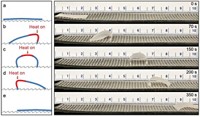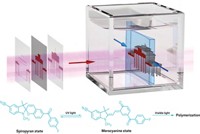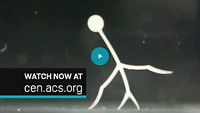Advertisement
Grab your lab coat. Let's get started
Welcome!
Welcome!
Create an account below to get 6 C&EN articles per month, receive newsletters and more - all free.
It seems this is your first time logging in online. Please enter the following information to continue.
As an ACS member you automatically get access to this site. All we need is few more details to create your reading experience.
Not you? Sign in with a different account.
Not you? Sign in with a different account.
ERROR 1
ERROR 1
ERROR 2
ERROR 2
ERROR 2
ERROR 2
ERROR 2
Password and Confirm password must match.
If you have an ACS member number, please enter it here so we can link this account to your membership. (optional)
ERROR 2
ACS values your privacy. By submitting your information, you are gaining access to C&EN and subscribing to our weekly newsletter. We use the information you provide to make your reading experience better, and we will never sell your data to third party members.
Materials
Polymer ribbons undulate and walk in UV light
Light-responsive material could eject sand and dust from self-cleaning solar panels
by Stu Borman
June 30, 2017
| A version of this story appeared in
Volume 95, Issue 27

Under a constant blast of ultraviolet light, a new polymer ribbon undulates with a continuous mechanical wave-like motion that can eject sand particles from the material’s surface and can transport a rod along the length of the film (Nature 2017, DOI: 10.1038/nature22987). When attached to a lightweight moveable frame, the waves can make the film “walk.”
One possible application of this writhing film is self-cleaning solar cells that remove sand and dust particles that accumulate on their surfaces and disrupt their function, say the researchers, led by Dirk J. Broer of Eindhoven University of Technology.
Other groups have developed materials that move in response to light. But those materials require that stimuli such as heat, humidity, and visible and UV light be applied to different parts of the device at specific times to make it expand and contract as needed, explains theoretician Robin L. B. Selinger of Kent State University, a coauthor of the new study. And in one case, a material oscillated in response to a fixed light source but didn’t produce directional waves, she says.
In the new system, the polymer ribbon moves autonomously and directionally when irradiated continuously with UV light at an oblique angle, without an experimenter controlling which parts of the material are illuminated and when.
The material consists of a liquid crystal network containing a highly light-sensitive azobenzene dye. The azobenzene isomerizes from trans to cis orientation in response to UV light, shrinking the material, and relaxes quickly back to trans when shaded, causing expansion. Together, these responses result in directional wave motion. “The thin polymer film flexes and generates its own shadows—what we call ‘self-shadowing’—so it autonomously changes which parts are illuminated and which parts are in shadow as a function of time,” Selinger says.
The liquid crystal molecules are perpendicular to the surface on one side of the ribbon and parallel to the surface on the other, making the two sides respond to light differently and allowing the direction of wave motion to switch when the film is flipped.
Smart and bio-inspired materials expert Nathalie Katsonis of the University of Twente comments that although the new material’s motion relies on physical shadowing, it nevertheless is a key step toward a long-standing chemistry goal: developing systems in which molecules and their collective action enable materials to move in controlled ways.
And in a Nature commentary accompanying the paper, polymer engineer Yanlei Yu of Fudan University says she anticipates such materials finding applications as “energy-harvesting devices, self-cleaning mechanisms, and miniaturized transport systems for use in poorly accessible places.”





Join the conversation
Contact the reporter
Submit a Letter to the Editor for publication
Engage with us on Twitter